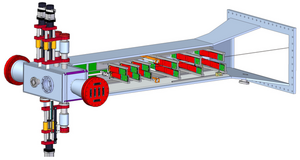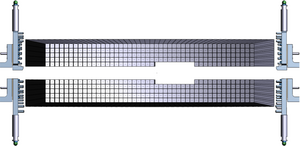Difference between revisions of "The HPS Run Wiki"
Jump to navigation
Jump to search
| Line 136: | Line 136: | ||
#* SVT L0: 1.5, 1.0, 0.5 mm | #* SVT L0: 1.5, 1.0, 0.5 mm | ||
#* Collimator: 2.82 mm, 2.25 mm | #* Collimator: 2.82 mm, 2.25 mm | ||
| − | #* 15 min. run | + | #* 15 min. run |
# FEE run | # FEE run | ||
#* Configuration: PROD66 | #* Configuration: PROD66 | ||
| Line 142: | Line 142: | ||
#* Target: 8 microns W | #* Target: 8 microns W | ||
#* Current: 150 nA | #* Current: 150 nA | ||
| − | + | # v6 NoHodoTET | |
#* Beam current 100 nA, or as high as SVT experts will agree on. | #* Beam current 100 nA, or as high as SVT experts will agree on. | ||
#* Configuration: PROD66 | #* Configuration: PROD66 | ||
Revision as of 16:29, 22 July 2019
[edit]
Phone NumbersShift ScheduleShift-Taker's ChecklistHot CheckoutBeam Time AccountingRun Spreadsheet 2019,2016, 2015HPS Upgrade ERRCOO, ESAD, RSAD Things to read before shift. |
Procedures
|
Manuals |
JLab Logbooks
|
HPS (E12-11-006) 2019 run, June X to August Y'
Beam energy 4.5 GeV
Important: Document all your work in the logbook!
Bluejeans for Run Meetings on DAY and DAY at 2pm
RC: Rafayel Paremuzyan
- (757) 575-7540
- 9 575 7540 from Counting Room
PDL: Valery Kubarovsky
- (757) 876-1789
- 9 876-1789 from Counting Room
* !! Chicane magnets can be energized only when the hall is in Beam Permit, [1]. Chicane magnets must be off if the hall is in Restricted or in Controlled access.
* Fill out BTA hourly. Click "Load from EPICS" to automatically fill the left side then make sure numbers are correct. If needed edit the entry. NO ABUs or BANU if beam tune is in progress, make it all BNA with ER 100%.
* Please close any GUI that is not being used, e.g. close harp scanner after harp scan is done, close chicane, after chicane is ON, etc
Run Plan July 20-21, 2019Hot items:
=================== task consequence ===============
Every Shift:
Every Run:
Important Notes:
|
General InstructionsEstablishing Physics Quality Beam for HPS:
Note: in order to have reliable readings on two important for HPS BPMs, 2H00 and 2H02, beam current should be >30 nA.
|
|
|
|---|
RC daily meetings at 2 pm in the counting-house 2nd-floor conference room.
BlueJeans Info:
URL: https://bluejeans.com/794825703
Meeting ID: 794825703
|
|
| ||||||||||||||||||||||||||||||||||||||||||||||||||||||||||||||||||||||||||||||||||||||||
|
Webcams:
|
Accelerator:
|
Slow Controls:
|
Online & Offline: |
| System/Person | Pager/Phone Number |
|---|---|
| Run Coordinator | (757) 575-7540 (cell) |
| Physics Div. Liaison | (757) 876-1789 (cell) |
| MCC-OPS | 7048 |
| Crew Chief | 7045 |
| Crew Chief | 9-879-3367 (cell) |
| Program Deputy | 9-876-7997 (cell) |
| Gate House Guard | 5822 |
| DAQ/Online | (757) 869-2188 (cell) |
| SVT | (757) 310-7198 (cell) |
| ECAL | (757) 810-1489 (cell) |
| Slow Controls | (757) 748-6922 (cell) |
| Beamline | (757) 303-3996 (cell) |
| Engineering | (757) 748-5048 |
| Hall-B Floor | 5165 |
| Hall-B Space Frame | 5170, 5171 |
| Hall-B Forward Carriage | 5371 |
| Hall-B Counting Room | 5126, 5244, 5246, 5247 |
| Hall-B Gas Shed | 7115 |

